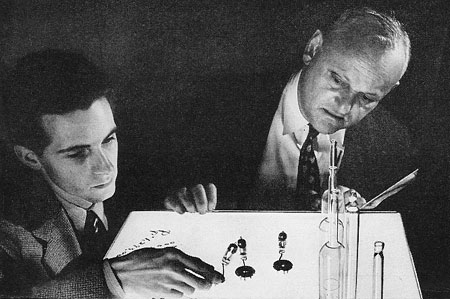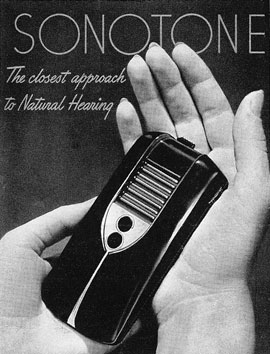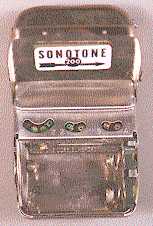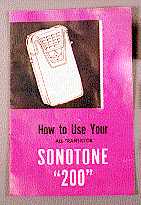Hearing Aids
By Roger Russell
These pages are copyrighted.
No portion of this site may be reproduced in whole or in part
without written permission of the author.
![]()

 The hearing aids were well designed and sophisticated
products. Sonotone manufactured various types of hearing aids. Shown at the
left is a 1940 model. The tiny new vacuum tube Sonotone (right) applied the
principle of the radio to making hearing easier. Initially, the microphone,
amplifier and batteries were in one unit, typically located in a shirt or
jacket pocket. A pair of thin wires ran to the receiver in the ear.
The hearing aids were well designed and sophisticated
products. Sonotone manufactured various types of hearing aids. Shown at the
left is a 1940 model. The tiny new vacuum tube Sonotone (right) applied the
principle of the radio to making hearing easier. Initially, the microphone,
amplifier and batteries were in one unit, typically located in a shirt or
jacket pocket. A pair of thin wires ran to the receiver in the ear.
Transistors, requiring much less space and current, later allowed for the design of a behind-the-ear unit and then for a complete in-the-ear hearing aid. Later, integrated circuits made it possible to locate the complete unit in the ear canal.
Shown at the right is a later model, the Sonotone 925
hearing aid. This was an all-tube unit measuring 2-5/16" wide,
4-7/16" high and 1-1/8" thick. It weighed 5 ounces without the
batteries. The volume control is at the upper right. An on-off switch is at the
upper left. It could be placed in a shirt or jacket pocket and held in place with
the gold clip. A special strap and cloth holder was also available for women.
The microphone was located behind the clip. A double contact socket was at the
top of the hearing aid for connection to the receiver.
Sonotone was the first to be in touch with Bell Labs
and initiate the use of transistors in hearing aids. In 1953, the Sonotone
Model 1010 transistor-tube hearing aid (left) won the first annual Audio
Engineering award for technical excellence in hearing aids. It was the
transition from tubes to transistors. It used two vacuum tubes in the first
stages for high signal-to-noise ratio and one output transistor to conserve
battery power. Cost of operation was considerably reduced compared to all tube
hearing aids without sacrificing quiet operation. A separate on-off switch and
volume control was again used. An accessory microphone and telephone pickup
were also available.
The Sonotone 200 (right) was an all transistor hearing aid. It was styled after the earlier 925 tube model (left). In comparison, the 200 measured only 1-7/8" wide, 3-1/16" high and 5/8" thick. It weighed 2.9 ounces without the batteries. The volume control is at the upper right. An on-off switch is on the left side. The switch in the upper left had several functions. In the down position, the hearing aid was in the bifocal mode that dimmed the background sounds in noisy places. In the middle position, the hearing aid was full on. In the up position, the hearing aid could be used as a telephone amplifier. The edge of the telephone earpiece could be placed against the hearing aid and the sound was picked up magnetically. You could then speak into the other end of the receiver.
 When the battery cover in the back was open, the
battery compartment could be seen at the bottom of the picture. It held one
Sonotone 600 battery. Also, the fitting controls are exposed. These can be seen
as curved slots across the center of the back. These switches allow adjustment
of the frequency response to compensate for individual customer hearing losses.
When the battery cover in the back was open, the
battery compartment could be seen at the bottom of the picture. It held one
Sonotone 600 battery. Also, the fitting controls are exposed. These can be seen
as curved slots across the center of the back. These switches allow adjustment
of the frequency response to compensate for individual customer hearing losses.
 A complete 16-page owners manual came with the 200
that explained how to use it and had many drawings. It included subjects like
how to care for the instrument, the air-conduction receiver, the
bone-conduction model, battery installation, how to wear it and how to use it
A complete 16-page owners manual came with the 200
that explained how to use it and had many drawings. It included subjects like
how to care for the instrument, the air-conduction receiver, the
bone-conduction model, battery installation, how to wear it and how to use it
It could be placed in a shirt or jacket pocket and held in place with the metal clip. A special "Sonowear" pouch suspended from the neck could also be used. The microphone was located behind the clip. A double contact socket was at the top of the hearing aid for connection to the receiver.
In addition, there were hearing aids built into
eyeglass frames, which were also available in left and right units for binaural
hearing. At the right is the Sonotone 400 eyeglass frame hearing aid with the
cover removed. This was an all transistor unit made of lightweight brown
plastic. The microphone was located at the rear of the eyeglass frame (left
side of the picture). A flip out battery holder was located next to the
microphone. The on-off switch was located at the top, about midway. The
receiver, located below the switch and inside the 400, connected to a coupling
at the bottom of the frame. A soft transparent flexible tube was attached to
the coupling and went to the ear and earpiece. The volume control was located
towards the front next to the receiver. The whole frame assembly weighed only
22 grams, or about 3/4 of an ounce without the battery. The frame was 3/8"
thick for the entire length.
The high-power shirt pocket hearing aids have since been replaced with an equally powerful in-the-ear model. Many of the hearing aids had adjustable frequency bands, like the model 200. Bone conduction units were also manufactured, bypassing the ear canal completely.
Bob’s Virtual Transistor Museum & History Web Site
![]()
Known Sonotone models
From “The Hearing Aid: Its Operation and Development” by Kenneth W. Berge, Published by The National Hearing Aid Society, Livonia, MI. 48152, P281, ISBN 0-911472-02-9
Carbon
Double Sonotone. Apr.1930. Double mic in tortoise shell case. Monogram “S” in large triangle on front of mic case. Evidently later numbered 300.
60. (Single Sonotone). 1930. Black metal mic 5.7 dia X 1.8 thick mounte battery, with rec and disc vol control.
Tiny Sonotone. 1930. M Metal mic 5.6 dia X 1.6 thick, rec, and disk vol control. May have been renamed "Junior".
200 (Convertible Sonotone). 1932. Double mic in oval molded case 13.OX6.9x 1.5 with small monogram "S" on front. On‑off switch on mic front and soft‑loud on side. Cylindrical vol control. B.C. arid either earphone or rec. Amplifier. Without B.C. and with larger monogram "S" on mic and no on‑off this was called 300. Without amplifier the 300 was called 400. With mother of pearl case model 400 was called 500.
600 (Excel). 1933. Like 200 plus carrycase for mic and batteries.
700 (Radio Aid). B.C. With B.C. and either earphone or rec called 701. Model 700 without B.C. called 702.
32.
33 (Super Sonotone). 1933. A. C. or B. C. Double mic in oval molded case 13.0 X 6.4 X 1.8. Off‑soft‑loud control on side. Opt vertical carry case.
34 (Super Sonotone). Jan. 19,34. Mic 6.4 dia X 1.6 thick. Separate on-off-loud control.
35:1. 1934. A.C. or B.C. Amplifier. mic 6.8 dia X 2.5 thick. Vol control slide at bottom of mic; no holes in front of mic, only a groove opening. Submodel 35:12 had battery plug connector flush with mic. instead of inset.
35:15. Double mic in oval molded case 13. 0 X 6.4 X 2. 1; no holes in front of mic, only a groove opening.
451. Mar. 1937. Mic. 7.5 dia X 2.9 thick; vol control at bottom.
499. 1938? Mic in oval molded case 13.3 x 6.4 X 1. 8. Off‑soft‑loud control on side of mic.
505. Sept. 1938. M ic 7.5 dia. Rec. Amplifier.
444. Feb. 1939. M ic 6.8 dia X 2.4 thick. A. C. or B. C. Vol control on lower front of mic.
Vacuum Tube
Portable Table Model. 1935? 2VT, ac. Case 21.7 X 14. 0 X 17.4. Double carbon inic inside at end of case B.C.
485 (Perceptron). 1937. 3VT, in case like folding camera of that era, with shoulder strap. Crystal mic. Crystal and magnetic rec. 23.9 x 12. 1 x 4.8.
520. Sept. 1939. 2VT, 2‑piece. Crystal mic A.C. or B.C. 12. 7 x 6. 2 x 2.5.
530. 1911? VT 2‑piece. A.C. 9.5 X 4.8 x 2. 1.
531. 1942. 2VT, 2‑piece. A.C. or B.C. 10.2 x 5.4 x 2. 1.
533. 1942. VT, 2‑piece. 12.7 X 6.2 X 2.5.
600. 1945? VT, 2‑piece. 10. 0 x 6.8 x 2.4. Submodel 70OX had battery area attached at bottom to make it 1‑piece. 14.9 X 6.8 X 2.4.
900. Sept. 1947. VT, I‑piece. 3‑position TC. Front case rhodiurn finish metal and back gray plastic 12. 1 x 6.5 x 2.5. Could also be worn 2‑piece.
50. 1948. Professional Table Set. ac or de. Metal case 16.5 x 11.5 x 11.4.
910. 1949. VT, I ‑piece. 9.4 X 5.7 X 2. 1.
920. 1949. VT, 1‑piece. Gray‑green and silver case 10.8 X 5.7 x 2. 1.
925. 1950? Same case as 920 but in cinnamon arid silver.
940. 1950. VT, I‑piece. Opt ext mic. 8.7 X 3.0 X 1.9.
966. 1950. 6vr, I‑piece. 11.9 X 6.2 X 2.5. Also available as 2‑piece.
977. 1951. VT, I‑piece. TEL. AGC. 8.7 x 5.4 x 2. 1.
988. 1952. VT, I‑piece. Opt ext mic. TEL. Metal case.
1010. Dec. 1952. 2VT & IT. Opt ext mic. TEL. Same case as 988. Won the First Annual Audio Engineering Award for technical excellence in the design and manufacture of hearing aids. One of the 1st if not the 1st aid with a T.
Body Transistor
1111. 1953. 3T. 122. 7.6 X 4.5 X 1.6. Based on patent #2,789,160 by Franklin A. Gage.
1200. 1954. 4T. TEL. 1.3/2.6/3.9 volts. Aluminum case.
1000. (Golden). 1961. 6T, PP. TEL. AGC. 401(2).
22. 1962. 6T, PP, TEL. AGC. 401(2).
45. Jan. 1968. 4T. 625. Case like 100.
77. June 1959. 6T. TEL. 401. 5.4 x 3.5 x 1. 6.
88. June 1959. 6T. 401(2). Circuit like 77. 5.9 X 3.5 X 1.6.
99. June 1959. 6T. 401(4). 8.9 x 3.5 x 1. 6.
100. June 1955. 4T. 625. Metal case 5.4 X 3.5 X 1.4. M ic opening 6 small horizontal holes. Modified with 2 additional mic openings and new vol control.
200. June 1956. 4T, PP. AGC. TEL. 122. 7.6x4.5x 1.6. Submodels: C (B.C.), E (A. C.) and X (high power).
300 1964. 6T, PP. Ceramic top mic. TEL, AGC. 401. Submodels: C (B.C.), E (A.C.) and X (two 401). May be 1st hearing aid with ceramic mic.
600 1967 5T, PP. Ceramic top mic. TEL. AGC, 401. Stainless steel case 6. 6 X 3.5 X 1. 8.
60OX. 1967. 5T, PP. TEL. AGC. 401(2). 8.8 x 3.5 x 1. 8.
612. 1975. Ceramic mic. TEL. AGC. 401. Submodel 612X.
670. 1972. 10T, PP, Top ceramic mic. 933. Silver case. Submodels. B (basic model), T (TEL, NIT. AGC.), S (TEL, NIT. AGC. Input control, output regulation), X (extra power), and XV Has four internal 3-position selector switches (X with LFE).
Behind-the-Ear
25 Mighty Wisp). 1963. 4T. AGC. 575.
36. 1972. Ceramic mic. 13. Submodels: 36‑13, 36‑21, 36‑21‑B2 (electret mic. CROS), 36‑22 (1973), and 36‑23 (1973. Electret mic. AGC.)
37 (Micro Wisp). Jan. 1969. IC, 3T. 13.
55 (Wisp). June 1961. 3T. 575. Modified as 58 in 1968 without separate on‑off switch and smaller mic opening.
70 (Sono‑Wisp). May 1965. 3T. S 13.
72. 1966. 4T. Automatic TEL. S76.
76. 1967. IC, 3T. S13. Case like 70 but front mic, and vol control to rear.
77. 1971. Front mic. TEL. S76. Submodels: S (ceramic mic), P (1973. Electret mic), and D (Ceramic or electret directional mic).
79. June 1955. Barrette or BTE, ext rec. 3T. 625. Plastic case 4.6 x 3.2 x 1.6. May be the first BTE aid.
80. 1970. IC, PP. Front mic. 675. Submodels: B (basic), A AGC T (TEL), arid S (Universal. AGC and TEL. Internal TC).
333. Feb. 1957. BTE or barrette. 4T. 400. Metal case 3.2 x 2.1 x 1.3 Based on patent #2,938,O83 in 1960 by Frank A. Herrmann.
Glasses
35. 1966. 4T. Automatic TEI. S76.
40. 1970. ‑IT. TEL. AGC. 675. Submodel 40‑6 in 1973.
50. 1972. Opt CROS arid TEL. 41.
66. 1960. 3T. AGC. 675. Submodel styles: 66E attached to EG and 66T BTE.
75. (Thinline). 1964. 4T. 312. Modified 1972 as 75‑2 (Thinline 11) with IC, 3T. TEL. 312.
400. Sept. 1957. 4T. AGC. 67 5. 1.8 x 1. 1.
410. Sept. 1958. 675. 1.8 X 1.4. Submodel styles E (EG) and T ("Tuck‑A‑Way" BTE).
430E (Sovereign). 1961. 4T. TEL. 675.
500. Sept. 1957. Like 400 but B.C. 1.7 X 1.4. One of the Ist if not the 1st B.C. EG aid.
40‑P. 1976. S76.
At-Ear and In-Ear
33 (Sonet). Jan. 1966. In‑ear. IC, 3T. 212. 3‑hole mic opening.
34 (Sonette). 1970. Like 44 with 312 arid 2‑hole mic opening.
44 (Wisp Ear). 1962. 1 n‑ear. 3T. 312. Metal case.
222. Feb. 1957. At‑ear. 3T. Metal case 2. 0 X 2.1 X 2.2. Based on patent #2,938,083 by Frank A. Herrmann.
![]()
|
About This Site |
||
|
|
More text and pictures about Sonotone will be added as my research continues. Any comments, corrections, or additions are welcome. |
|
|
Email
to |
|
All
contents are copyrighted |